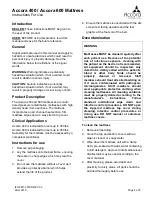
24
WYMIANA
OGUMIENIA
(dotyczy
wózków
wyposażonych w koła pompowane)
Przed przystąpieniem do wymiany ogumienia należy
zapoznać się z poniższymi uwagami.
W pierwszej kolejności należy wypuścić z dętki
powietrze a następnie poprzez naciskanie na oponę w
kierunku środka felgi poluzować kontakt opona-felga.
Stosując specjalną łyżkę należy wyciągnąć rant opony
na zewnątrz rawki, co umożliwi przełożenie całej
ścianki opony na zewnątrz. Po tym zabiegu
wyciągnięcie dętki jest już bardzo naturalne.
Przed założeniem nowej dętki prosimy zwrócić uwagę
na to aby:
taśma spodnia była nieuszkodzona i nie posiadała
obcych ciał,
ścianki zewnętrzne rawki były gładkie, bez obcych
wtrąceń i innych uszkodzeń.
W razie konieczności taśmę spodnią i rawkę należy
dokładnie wyczyścić.
W celu zamontowania ogumienia należy nałożyć taśmę
spodnią otworem na wentyl, a następnie założyć razem
do gniazda w rawce. Utrzymując takie położenie
nałożyć taśmę spodnią na całym obwodzie felgi
zwracając uwagę, czy nie nastąpiło przekręcenie taśmy
lub czy nie uległa ona uszkodzeniu i dobrze przykrywa
napinacze szprych.
Odciągając ściankę opony od rawki, włożyć wentyl do
gniazda w feldze i lekko napompować dętkę tak aby
uzyskała ona okrągły kształt po czym umieścić dętkę w
rawce.
Dla całkowitej pewności należy sprawdzić czy dętka nie
jest przekręcona (w przypadku załamań lub deformacji
minimalnie dopompować powietrze). Nałożyć ręcznie
ściankę opony na rawkę zaczynając od przeciwległej
strony wentyla , a przy nim kończąc.
Zawsze należy sprawdzić po obu stronach koła czy
dętka nie została przyciśnięta przez oponę i czy
ogumienie regularnie przylega do felgi. Wentyl trzeba
lekko wcisnąć do środka, a następnie wycisnąć na
zewnątrz po to, aby ten dobrze osadził się w gnieździe.
Aby sprawdzić prawidłowość przeprowadzonego
montażu ogumienia należy napompować tyle powietrza
żeby móc kciukiem docisnąć do dna rawki. Następnie
sprawdzić czy opona jednakowo przylega po obu
stronach do felgi i czy jest ona centralnie ułożona. Jeżeli
wystąpią takie usterki to należy wypuścić powietrze z
koła i poprawić osadzenie gum. Po pozytywnej opinii
należy koło napompować do maksymalnej wartości
CHANGE OF TYRES (It applies to stroller fitted with
wheels pumped)
Before beginning the change of tyres it is necessary to
get acquainted with the following notes.
First, it is necessary to release air from an inner tube and
then by pressing a tyre in the direction of the centre of a
rim to loosen a tyre-rim contact. Using a special spoon it
is necessary to pull a tyre border out of the rim what will
give the possibility to shift the whole wall of the tyre
outside. After this operation pulling the inner tube out is
very natural.
Prior to the installation of a new inner tube attention
should be devoted to ensuring that:
a bottom band is not damaged and has not
foreign bodies,
external walls of the rim are smooth, without
foreign insertions and other damages.
The bottom band and rim should be precisely cleaned if
need be.
To install the tyres it is necessary to put a hole of the
bottom band over a valve, and then put together to a
seating in the rim. Keeping such a position, put the
bottom band on the whole perimeter of the rim, paying
attention to ensuring that the band is not twisted or
damaged and it covers spoke tighteners thoroughly.
Pulling the tyre wall away from the rim, insert the valve
to the seating in the rim and slightly pump the inner tube
that it achieves a round shape and then to put the inner
tube in the rim.
To be sure, it necessary to check if the inner tube is not
twisted (in case of deviation or deformation, pump air
additionally). Manually put the tyre wall onto the rim,
starting from an opposite side of the valve and ending by
it.
It is necessary to check on both sides of the wheel if the
inner tube is not pressed by the tyre and if the tyre
regularly adheres to the rim. The valve should be
slightly pressed inside and then repressed outside that it
sets well in the seating.
To check that the tyre installation is correct it is
necessary to pump such air that it is possible to press a
thumb to the bottom of the rim. Then, check if the tyre
adheres evenly to the rim on both sides and if it is
centrally arranged. If such defects occur it is necessary
to release air from the wheel and correct the setting of
the tyres. When an opinion is positive it is necessary to
pump the wheel to the maximum pressure value and put
a cap onto the valve end.






































